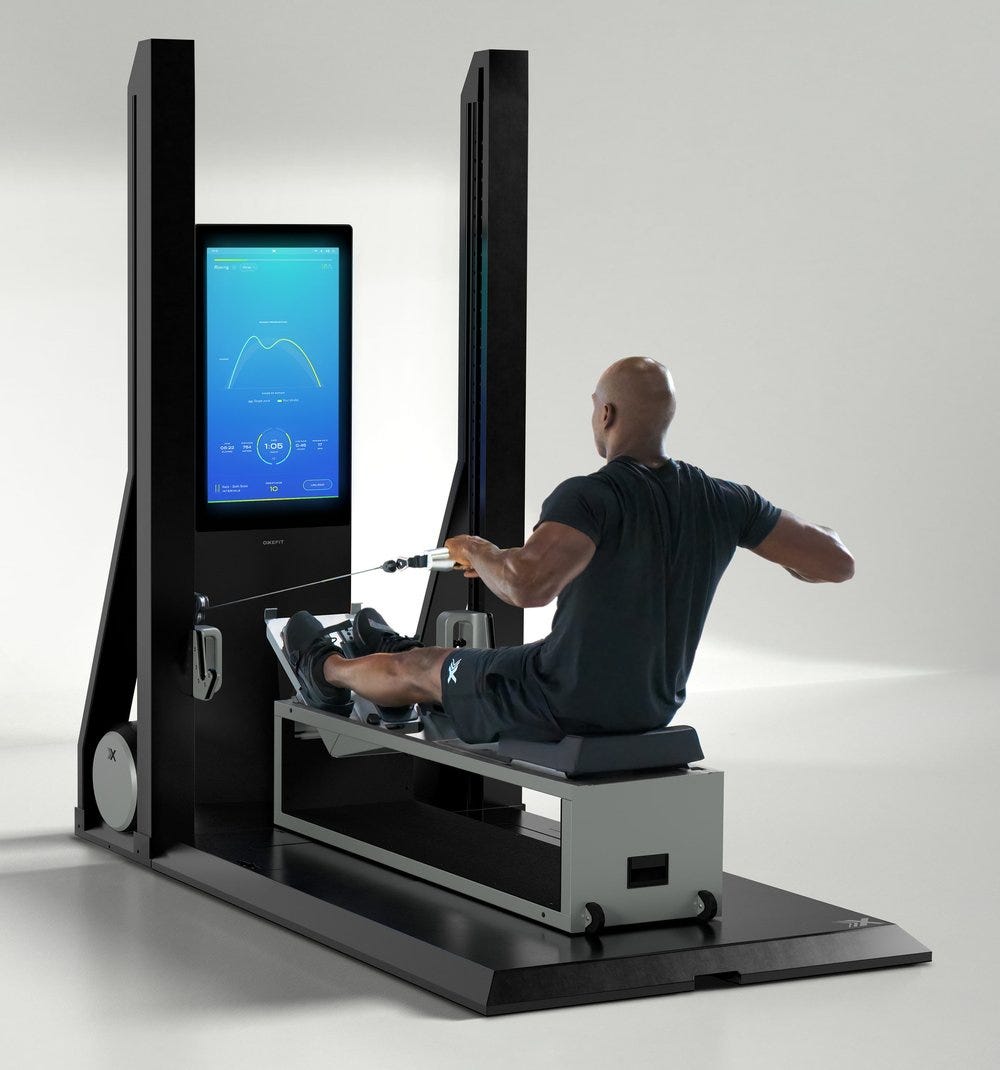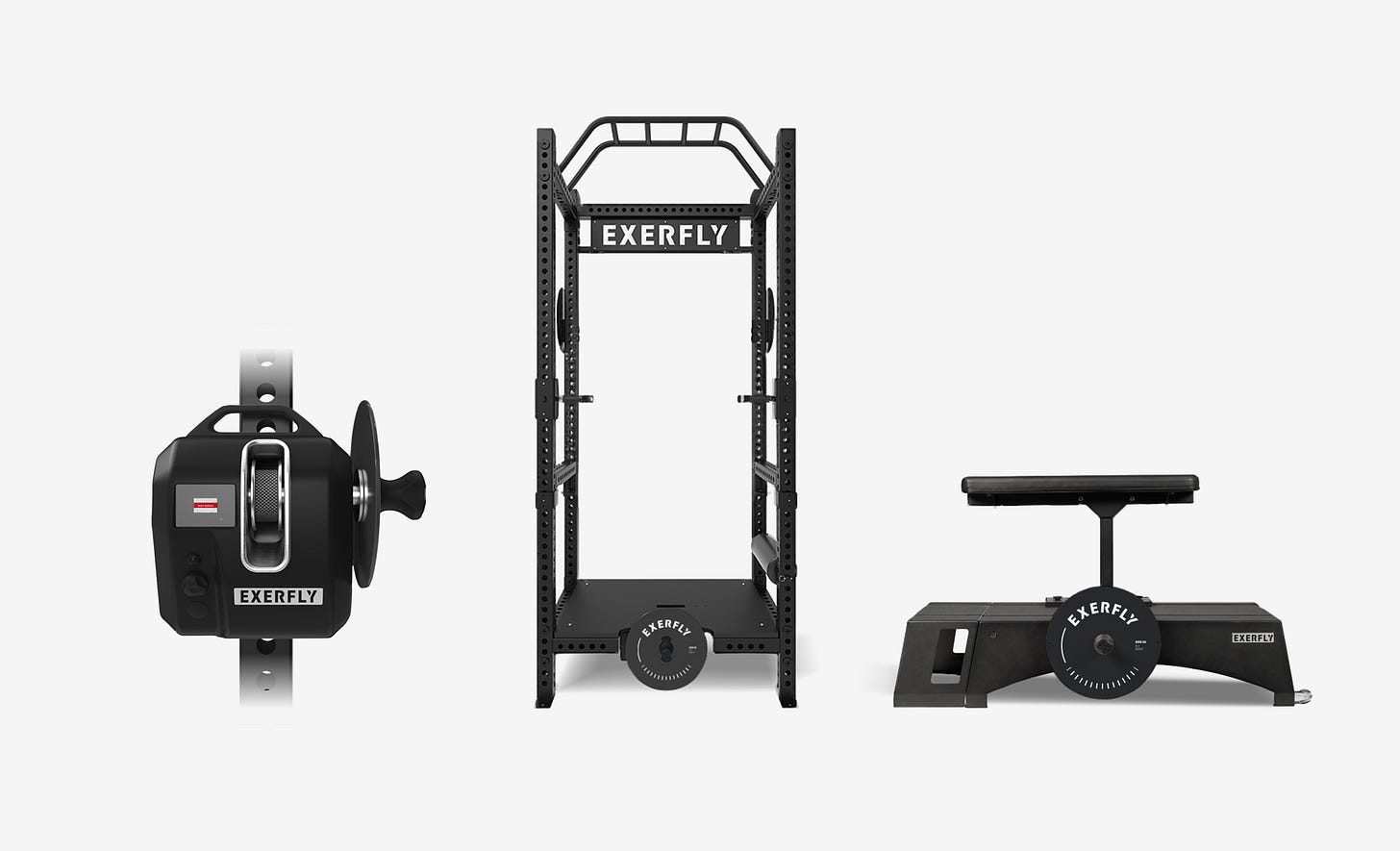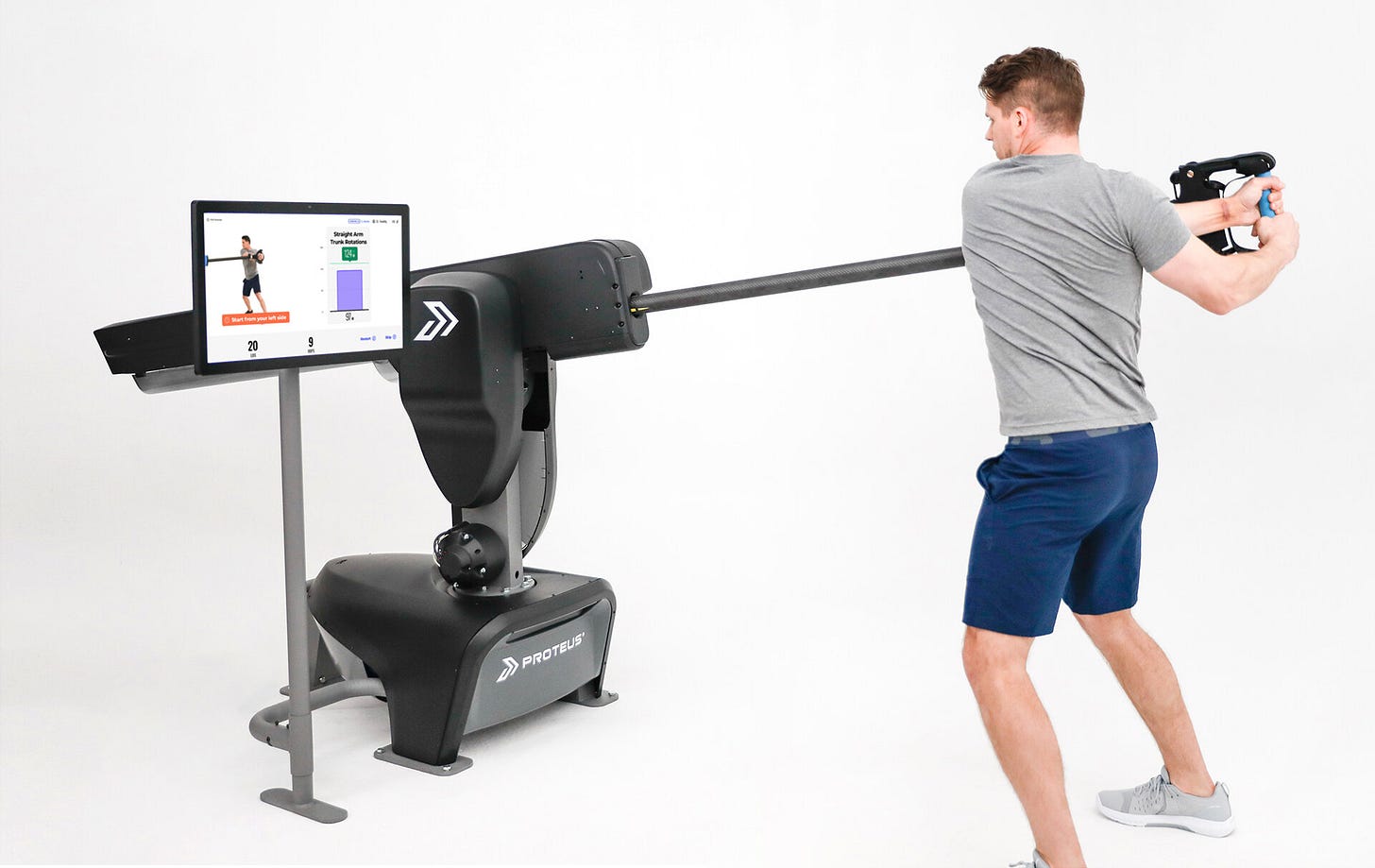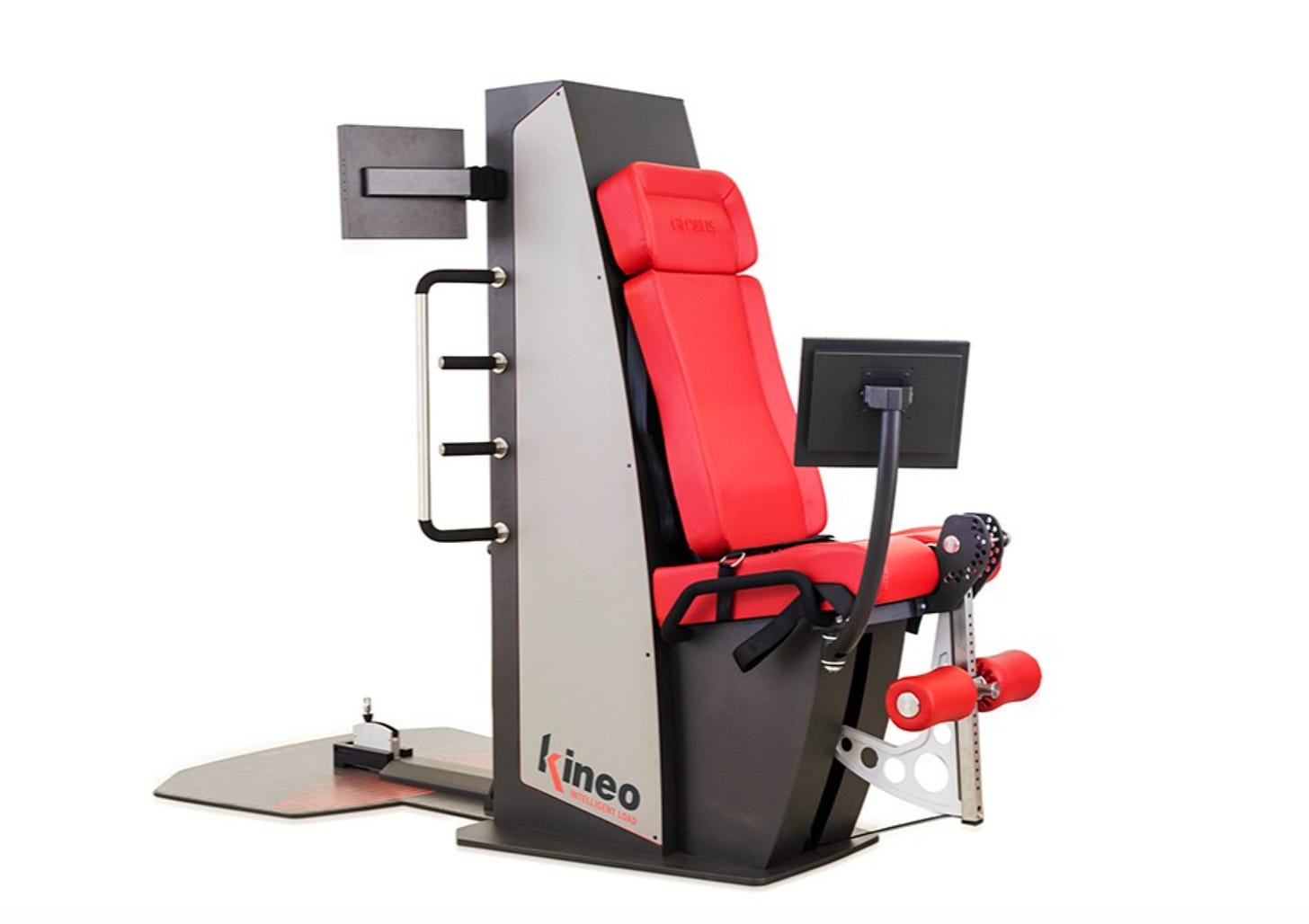🏋️ Upside Analysis: Resistance Training Vendor Ecosystem: Key Drivers, Challenges, Stats, Use Cases, Vendors, Recommendations to Teams
In high-performance sports, resistance training has historically been the foundation of strength and conditioning. However, over the past decade, there has been a seismic shift from traditional, manually controlled equipment to smart, programmable, and data-driven resistance systems. These systems allow for highly controlled, measurable, and adaptable training environments tailored to the individual athlete’s biomechanics, injury history, and performance needs.
The emergence of this vendor ecosystem reflects broader trends: athlete monitoring, sports science integration, return-to-play optimization, and individualized load management. These systems go beyond simply making athletes stronger — they enable practitioners to detect early warning signs of injury, refine movement patterns, track recovery, and align training with sport-specific neuromuscular demands.
From robotic resistance and isokinetic machines to motorized dumbbells and smart cables, the vendor ecosystem is now a vital component of elite performance departments. Teams across the NFL, NBA, NHL, MLS, and NCAA — along with Olympic committees and military organizations — are embedding these technologies into their daily workflows.
Market Size
The market for resistance training solutions — particularly smart, data-integrated technologies — is expanding at a steady pace, driven by increasing demand for precision in athlete development.
Key Market Insights:
Strength Training Equipment Market: Estimated at $14.04 billion in 2025, projected to reach $17.74 billion by 2030, with a CAGR of 4.79%, according to Mordor Intelligence.
Source: Mordor Intelligence, 2025
Elite Sports Spend: Professional and collegiate teams now spend between $50,000–$500,000 per year on performance tech, with resistance systems often representing the largest capital investment outside of force plates and GPS.
Regional Trends:
North America: Leads in adoption, driven by NFL, NCAA, and Olympic integration.
Europe: Rapid growth in soccer and handball, with flywheel and robotic systems integrated into youth academies.
Asia & Middle East: Driven by national Olympic programs and military contracts.
The financial case for these tools is increasingly clear: they reduce injuries, accelerate return-to-play, and help teams make better training decisions — all of which impact wins, losses, and athlete careers.
Strong Adoption Across Major Leagues
Widespread adoption across elite performance environments highlights the transition from experimental to essential. These systems are no longer "nice-to-haves"; they’re performance essentials and are used across various leagues (NFL, NBA, MLS, NCAA, Olympic sports..) and the military sector today.
NFL / NBA / MLS /NCAA: The majority of teams use smart cable systems in either rehab, testing, or VBT.
Olympic Sport: Full integration at USOPC, EIS (UK), and AIS (Australia) for strength diagnostics and injury mitigation.
Military: U.S. Special Operations and NATO partners are now integrating smart, portable resistance systems for deployable strength training and rehab in-theater.
This widespread adoption is driven by both performance gains and risk mitigation — especially as athlete health, load management, and return-to-play timelines become performance-critical.
Key Use Cases
The application of these systems varies widely across sectors, but several dominant themes have emerged:
1. Return-to-Play (RTP)
Real-time force and asymmetry monitoring
Controlled eccentric/concentric phases
Replication of sport-specific loads under supervision
Integration into RTP decision-making frameworks
2. Power Profiling & Load Prescription
Force-velocity profiling across joints/movements
Identifying neuromuscular bottlenecks (e.g., weak takeoff strength, slow RFD)
Prescribing loads based on daily bar speed
Monitoring chronic load tolerance over a season
3. Injury Risk Reduction
Eccentric overload to reinforce tendon-muscle junctions
Unilateral testing to spot strength deficits early
Use of VBT to monitor fatigue and prevent overtraining
4. Travel & Remote Training
Voltra dumbbells allow remote load control and progress tracking
OHM and Beyond Power used during road trips to minimize performance dips
Cloud-based systems offer coach oversight even off-site
5. Sport-Specific Conditioning
Sprint-resisted cords (1080 Sprint) simulate match velocity and acceleration load
Tennis and baseball teams use resistance tracking to profile swing speeds
COD-resisted drills used in ACL and lateral chain rehab
These use cases not only optimize performance, but also integrate deeply into medical, rehab, and coaching workflows.
Key Drivers
Several strategic forces are accelerating the adoption of advanced resistance systems:
Data-Driven Coaching: Greater emphasis on evidence-based decisions in pro and college sports
Injury Reduction Mandates: Financial and performance pressures to reduce injury rates and shorten RTP
Sport-Specific Individualization: Increasing demand for customized load and velocity profiles per athlete
Integrated Systems: Desire for interoperability with GPS, force plates, HRV, and athlete management systems (AMS)
Remote Athlete Management: Post-COVID trend toward mobile systems for traveling teams and decentralized rehab
Recruiting & Branding: NCAA and Olympic organizations use tech-forward facilities to attract elite talent
The convergence of performance science, technology, and health economics continues to push this sector forward.
Key Challenges
Despite the growth, several systemic challenges remain:
Capital Costs: Some systems can be expensive; pricing may limit access for smaller schools or startups
Data Overload: Teams risk collecting data without actionable insights; staff must be trained to interpret and implement findings
Integration Gaps: Difficulty syncing with other systems (AMS, GPS, medical records) can create data silos
Adoption Lag: Non-technical staff or coaches may resist or misuse tech if not onboarded well
Ruggedization Needs: Portability and durability remain issues for military and outdoor use
Scalability: Hard to scale 1-to-1 systems across large rosters (e.g., football, tactical units)
Mitigating these issues requires thoughtful implementation, staff training, and long-term planning.
Key Vendors – Comparison
Source: Companies’ website, Upside Global, 2025
1080 Motion
1080 Motion is widely used for its robotic load control and ability to assess sprint and force-velocity profiles. It's a staple in elite track, NFL, and Olympic settings, especially for return-to-play benchmarking. High price point, but best-in-class for speed development and precise resistance tracking. 1080 Motion products, specifically their training systems, range in price from ~$17,800 to ~$50,000.
Beyond Power
Beyond Power offers smart cable resistance with real-time velocity data, making it a strong entry point for teams adopting VBT. It excels in strength profiling, in-gym rehab, and mobile resistance circuits. The compact design and mid-range price make it attractive for collegiate and performance labs. The Beyond Power product (VOLTRA) typically costs $2400-$2500 per unit.
OxeFit
OxeFit is a fitness technology company founded in 2019 and headquartered in Plano, Texas. It specializes in developing AI-powered strength training systems that integrate robotics, movement tracking, and performance analytics to provide personalized and effective workouts. Their flagship products, the XS1 for home use and the XP1 for commercial settings, offer a comprehensive range of exercises, including strength training, cardio, Pilates, and aquatic sports simulations. These systems feature dynamic variable resistance, real-time feedback, and a growing library of on-demand classes, aiming to enhance user engagement and performance. OxeFit's innovative approach has attracted investments from notable athletes and has been adopted by various fitness centers, sports teams, and rehabilitation facilities . The OxeFit machine typically costs ~$4000 + accessories ($2350).
OHM
OHM uses magnetic motors to deliver smooth, silent, joint-safe resistance, perfect for rehab, military, and tactical settings. It's especially valuable in cases where noise, portability, or low-impact training are critical. While not a replacement for heavy lifting, it excels in load-sensitive contexts. The OHM Run costs $5995 to $6545.
Aris
Aris is built for dual-limb diagnostics, especially in lower-body RTP workflows (e.g., ACL, Achilles). It tracks asymmetries and force outputs at high precision, often used in RTP decision-making and injury-risk assessments. A premium option, but highly trusted in elite RTP settings. The ArisPro costs $4500 per unit.
Exerfly (Recently acquired by Dynamic Fabrication and Finishing)
Exerfly is a cost-effective flywheel-based system delivering eccentric overload for strength and power adaptations. It’s portable, easy to scale across teams, and backed by research in rugby, soccer, and basketball. It doesn’t offer native force diagnostics but is great for high-volume training blocks. Exerfly devices start at $4,064.
Proteus Motion
Proteus is a 3D resistance system designed to assess and train movement across multiple planes simultaneously. It captures output data across rotational and linear movements, making it ideal for return-to-play and throwing sports like baseball or tennis. It’s premium-priced and used mostly in labs or high-end facilities. The Proteus Motion resistance training system costs $149 for the initial screening and $49 for re-tests, which occur 3-4 times a year, according to Proteus Motion. Additionally, a general power test is $50, but may be free with the purchase of a personal training package, according to Great lakes physical medicine. The Proteus Motion machine itself may be sold for $10,000, as seen on OfferUp.
Kineo
Kineo integrates pneumatic, flywheel, and isometric resistance into one diagnostic system built for high-precision rehab and performance. Its standout feature is adaptive resistance targeting eccentric phases, isokinetics, and specific rehab protocols (e.g., post-op knees). Common in European soccer and sports medicine clinics. The cost of the Kineo Leg press is ~$11,000 per unit.
Recommendations to Teams
For Pro Teams:
Implement a dual-system approach for resistance training: one optimized for high-performance development, and another specialized in return-to-play (RTP) diagnostics and assessments.
Use portable, adaptable resistance training systems for on-the-road sessions, especially during congested travel periods such as in basketball and soccer leagues.
Designate a performance technology coordinator to manage data workflows, integrations, and cross-department communication.
For NCAA Programs:
Begin with accessible, multi-sport solutions that offer velocity-based training (VBT) and force profiling capabilities.
Incorporate low-impact, space-efficient rehab tools to support recovery across all sports, including non-revenue programs.
Utilize student interns or graduate assistants as data liaisons to support implementation without overwhelming full-time staff.
For Olympic Teams:
Create custom force-velocity profiling models tailored to each sport and position.
Integrate resistance training metrics with neuromuscular and positional load data (e.g., EMG and GPS) for holistic monitoring.
Standardize injury risk thresholds using bilateral strength and asymmetry data.
For Military / Tactical Units:
Prioritize durable, portable resistance systems that can be deployed in diverse environments.
Develop readiness, return-to-duty, and remote coaching protocols anchored in resistance training data.
Use longitudinal resistance data to create resilience models for high-risk job categories.
Conclusion
The resistance training vendor ecosystem is a high-impact, rapidly growing domain in elite sports and tactical training. These technologies are not merely replacing iron — they’re redefining what it means to train with intelligence, precision, and purpose.
For organizations that can integrate smart resistance systems into performance workflows, the benefits are immense: fewer injuries, faster recovery, smarter loading, and improved performance outcomes. The future belongs to teams that connect data, movement, and mission — and smart resistance is at the center of that performance equation.
You may also like:
💪 Upside Analysis: Velocity Training Vendor Ecosystem: Key Drivers, Challenges, Use Cases, Vendors, Recommendations to Teams
Velocity-based training (VBT) represents a paradigm shift in strength and conditioning—from static percentages to dynamic, real-time feedback. By measuring the speed at which an athlete moves a load (typically a barbell), coaches can infer intent, fatigue, neuromuscular readiness, and training adaptations. VBT allows practitioners to move beyond guesswo…












